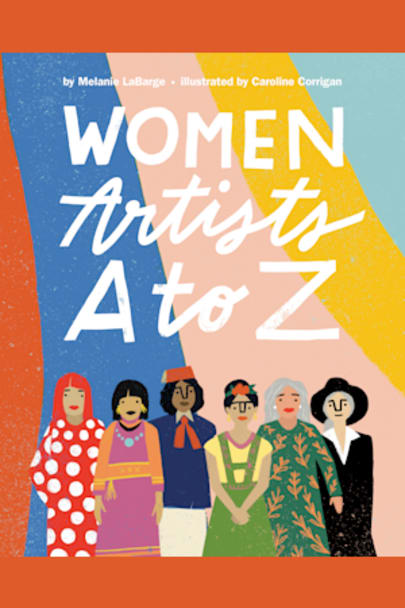An empowering and educational alphabet picture book about women artists, perfect for fans of Rad American Women A-Z.How many women artists can you name? From Frida Kahlo and Georgia O’Keeffe, to Jaune Quick-to-See Smith and Xenobia Bailey, this lushly illustrated alphabet picture book presents both famous and underrepresented women in the fine arts from a variety of genres: painting, drawing, … of genres: painting, drawing, sculpture, photography, and more. Each spread features a simple line of text encapsulating the creator’s iconic work in one word, such as “D is for Dots” (Yayoi Kusama) and “S is for Spider” (Louise Bourgeois), followed by slightly longer text about the artist for older readers who would like to know more. Backmatter includes extended biographies and discussion questions for budding creatives and trailblazers.
Artists featured: Mirka Mora, Betye Saar, Helen Frankenthaler, Yayoi Kusama, Kay Sage, Georgia O’Keeffe, Agnes Martin, Jaune Quick-to-See Smith, Elizabeth Catlett, Judith Leyster, Leonora Carrington, Carmen Herrera, Edmonia Lewis, Maya Lin, Hilma af Klint, Maria Martinez, Gee’s Bend quilters, Frida Kahlo, Louise Bourgeois, Loïs Mailou Jones, Alice Neel, Helen Zughaib, Ursula von Rydingsvard, Dorothea Lange, Xenobia Bailey, and Maria Sibylla Merian.
more



Women Artists A to Z
Melanie LaBarge
Illustrated by Caroline Corrigan
Dial Books, 11 Feb 2020
64 pages
Children’s Art History, Art History, Women’s History, Women’s Art
Provided by Edelweiss
The cover is a colorful, appealing cartoon-style banner that will surely catch many an eye on the shelves in any bookstore. It will especially appeal to women and girls who will want to know who these women are.
And what a lovely surprise there is inside for them. I have a BFA and was surprised. There are artists in this book that never came up in my art history classes; and I’ve had two full semesters of it with Sister Marie, as well as another two semesters of Modern and Contemporary Art with another professor. The author chose to work through the A to Z portion of the book in techniques, which was very interesting. You don’t usually see dots or boxes as a technique, but these artists were well known for their styles with these things. She included quilts as well, which I always love to see included as an art technique, having been a quilter for many years. I must say, I was sort of confused when I expected something with an A and the first page was MIRKA MORA, who I was completely unfamiliar with. Well, the technique or style was Angels, so that was the A! That set the pace for the whole book. I was very pleased to see this… boxes, color, dots, eggs, flowers. You get the idea? I did know some of the artists, Helen Frankenthaler and her colorful field paintings, Georgia O’Keefe’s flowers, Carmen Herrera and her lines, but I must admit to knowing fewer than half of them. So this little gem of a book is a total delight to me. These women are actually well-known by their artwork, but not by their names. As in, yes, I’m well aware of the lovely black on black pottery made by the San Ildefonso Pueblo community, but I didn’t know the name Maria Martinez – P is for Pottery. And as a knitter and artist, I am well aware of the non-traditional knitting being done as mandalas and such, but I was unaware of the name Xenobia Bailey – Y is for Yarn. But I did know Dorothea Lange and her pictures of people during the Great Depression, X is for EXposure.
Once you get through the alphabet part of the book and learn about techniques and the artists that do them, then there is the biographical section for each of the artists. It’s done in the same order as the front part and shows the face of each artist as well as their name, dates they lived, the place they lived, and a brief bio including a brief analysis of their style. Following each artist, there is a question or two for the reader to think about how they might work in the artist’s style. It’s very clever and draws the reader into each artist more than just a bio would. It’s also encouraging to see so many cultures and colors represented in the line-up.
Who would I recommend this for? Well, any parent could easily read this to their child and have no problem with it. The pictures are very appealing and will draw the child in. The text portions are brief and easy to work with. Then you can have a drawing session and see which artist your child is! The reading isn’t beyond the ability of middle schoolers and up (high school, college, and adults). This would be a fabulous book for an art teacher to use with a class to let students learn about techniques and try them out as well as to learn about different artists. Possibly do a paper on an artist and do an original piece in the artist’s style. Then have an art show! This book is a gem of information about techniques and artists, I can’t imagine that any school library wouldn’t want it on their shelves. For any child who dreams of being an artist, this would be a wonderful gift. Highly Recommended.